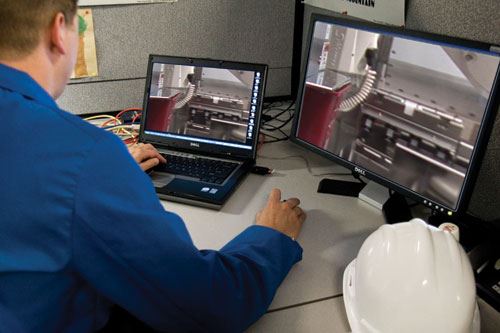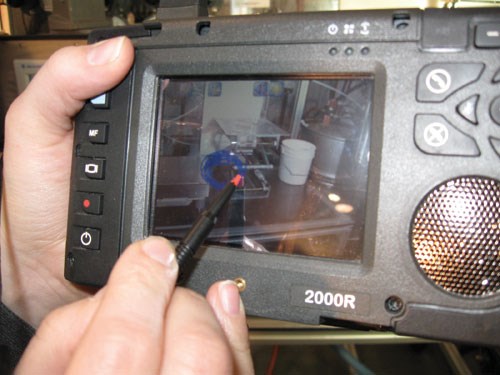Advances in Video Collaboration
How manufacturers can take video collaboration outside of the office and onto the shop floor.
Video conferencing has become a standard form of communication across enterprises. In fact, video conferencing is expected to become a $10.8 billion industry by 2015. The standard form of video collaboration facilitates face-to-face meetings in video conferencing meeting boardrooms. For mold manufacturers, though, the heart of their business is often the shop floor—where traditional video conferencing doesn’t reach. With the development of new mobile technologies, the opportunity for video collaboration has expanded onto the shop floor, to a supplier or customer location, or into the field where the problems are occurring.
Mobile technologies generally include wireless video devices for use on the plant floor and collaboration software for the remote experts’ desktops. Shop workers use the mobile device to share video, voice, telestration (i.e., onscreen drawing) and images with the experts who interact live through the collaboration PC software in a totally secure manner.
Procter and Gamble, the consumer packaged goods manufacturer with plants in more than 80 countries, has thousands of internal and external experts specialized in the full manufacturing process. Because these individuals are often located in places other than the manufacturing facilities, travel was often required to solve problems. For the engineers performing assessments of plastic injection molds from suppliers, this travel was costly in dollars, and personally. They spent half of their time flying all over the world to supplier locations.
The Injection Mold Capability Group piloted a solution of six mobile video devices and 10 collaboration desktops a few years ago. This solution turned out to be the answer and the core team of engineers started shipping a mobile device to a supplier location, or sending one engineer with the mobile device who could then bring in multiple specialists remotely. This initial use evolved and the mobile video solution is now deployed across the majority of internal manufacturing facilities as well as key supplier and OEM vendor locations globally.
Reduced Downtime
Mobile collaboration helps in various operational situations, including production line equipment maintenance and repair. If a machine is down and the right engineer is not available onsite to troubleshoot the problem, downtime rapidly escalates.
By using the mobile video device to show a remote expert the failed equipment, the manufacturer is able to remove costly delays from the repair process. Together, the production line engineer and remote specialist can now collaborate to identify immediate corrective action plans. In essence, mobile technology brings the problem to the expert, as opposed to the other way around.
Improved Supplier Interaction
Supply chain interaction and OEM vendor communications are streamlined though mobile collaboration. Design reviews and first-run production samples are an ongoing part of standard communication with suppliers.
Normally, team members travel to the supplier locations for live interactions, introducing delays into the process. Instead of travel, the mobile devices are kept or shipped to major suppliers to perform live visual communication when needed. The camera optics within these mobile devices are so advanced that remote experts can see detailed design aspects where even a fraction of a millimeter matters.
In some cases, third-party cameras—such as microscopes or borescopes—can also be attached to the mobile device to provide enhanced detail. By interacting live with suppliers on the shop floor, manufacturers accelerate product delivery, reduce travel costs, and leverage scarce expert resources in their own company and that of their supply chain partners.
Remote OEM Vendor Reviews
Before purchasing new equipment, some manufacturers often conduct a vendor-acceptance-test (VAT) stage at the vendor's location. This equipment is expensive, large and heavy so they have to be sure that it meets their specifications prior to accepting the shipment of the new equipment to their facilities.
The VAT requires a cross-section of specialized skills from the interested company’s team to properly execute and interpret the test results. Manufacturers traditionally had to send an entire team of specialized engineers to the vendor’s location, which was very expensive and time-consuming. Now, a group of experts in a variety of locations can simultaneously perform the review from their respective offices.
Network Requirements
While many benefits and cost savings opportunities are related to using mobile video collaboration on the shop floor, it is important to consider the infrastructure requirements. The main requirement is that the mobile devices need either an Ethernet or wireless network connection to access the Internet.
Wireless connectivity (i.e., 802.11 b/g) is the most common method used at a manufacturing plant to keep the device mobility level high. While manufacturers have often invested in wireless networks to share equipment sensor data, these networks were not always constructed with video in mind. As a rule of thumb, most manufacturers use video settings for their mobile devices that require approximately 500 kbps of bandwidth at the plant. However, this mobile video collaboration can be successful with less than 500 kbps as well.
Wireless Alternatives
Another alternative to consider is the use of 3G or 4G cellular networks through mobile Wi-Fi hotspot devices such as the MiFi or Cradlepoint. By using a hotspot device, a wireless network can be created for the mobile device anywhere there is adequate cellular coverage.
Extending Collaboration Power
With the advent of mobile technologies, securely extending the power of video collaboration across a manufacturing enterprise is now a reality. Manufacturers have proven that mobile video helps reduce downtime, drive quality improvements, accelerate product delivery, leverage experts and eliminate unnecessary travel.
Video is now an essential component of interaction between manufacturing facilities, suppliers, customers and OEM vendors. For many manufacturers, engaging in a video collaboration session has become as simple as making a phone call.
Related Content
The Benefits of Hand Scraping
Accuracy and flatness are two benefits of hand scraping that help improve machine loop stiffness, workpiece surface finish and component geometry.
Read MorePlastic Prototypes Using Silicone Rubber Molds
How-to, step-by-step instructions that take you from making the master pattern to making the mold and casting the plastic parts.
Read MoreConsiderations for Mold Base Material Selection
Choosing the right material can greatly affect the profitability and cost of your application.
Read MoreFundamentals of Designing the Optimal Cooling System
The right mold components can help improve mold cooling and thereby produce higher-quality parts.
Read MoreRead Next
Collaboration Leads to Complete Turnkey System
To meet the special needs of this project, ICU, Husky and Tech Mold worked together to design a complete turnkey system—including machine, mold, hot runner and temperature controller.
Read MoreHow to Use Strategic Planning Tools, Data to Manage the Human Side of Business
Q&A with Marion Wells, MMT EAB member and founder of Human Asset Management.
Read MoreAre You a Moldmaker Considering 3D Printing? Consider the 3D Printing Workshop at NPE2024
Presentations will cover 3D printing for mold tooling, material innovation, product development, bridge production and full-scale, high-volume additive manufacturing.
Read More














_300x250 3.png;maxWidth=300;quality=90)



.jpg;maxWidth=300;quality=90)










